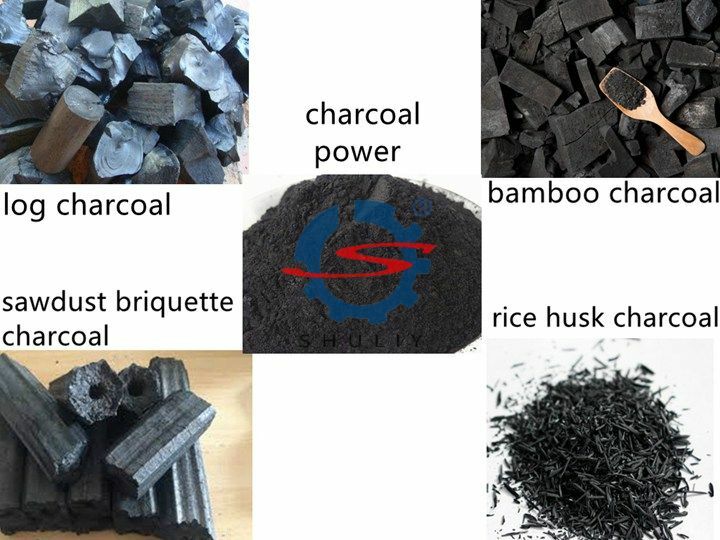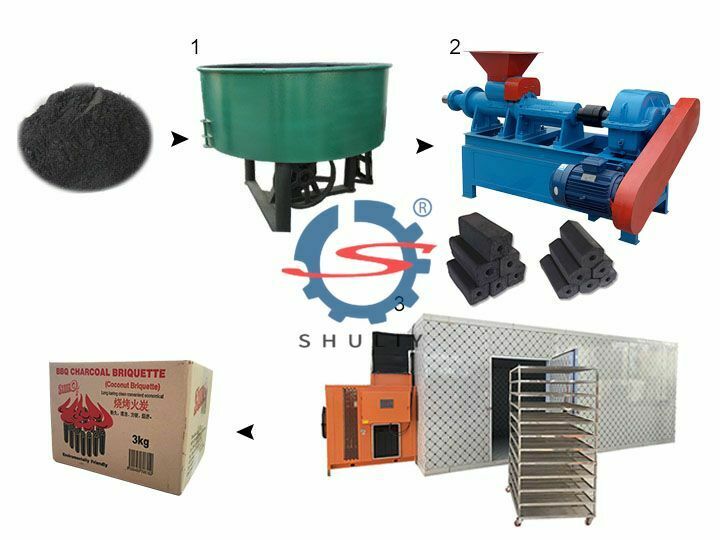Biomass Charcoal Briquettes: Features, Benefits & Process
Biomass charcoal or biomass briquette is widely used in so many developing countries. It is a kind of sustainable fuel energy made from biomass raw material, such as coconut shell, sawdust, rice husk, palm kernel shell, bamboo, wasted wood, etc. It has the features of versatile uses, low emission, high energy density, and so on. So what is biomass charcoal? What are biomass briquettes used for? How to make biomass charcoal? Here are the answers.

What is biomass charcoal?
Biomass charcoal is a solid material that is produced by heating biomass, such as wood, bamboo, or agricultural waste, in the absence of oxygen. This process, called carbonization, converts the biomass into a charcoal-like substance that can be used for a variety of purposes. The charcoal produced has a higher carbon content than the original biomass, and it is also more dense, durable, and has a higher calorific value. Biomass charcoal can be used as a fuel, in agriculture, water filtration, and other industrial processes.
It is considered a renewable energy source because it is produced from renewable materials, and it is also considered to be carbon negative which means that it can absorb more carbon from the atmosphere than it releases during production.
Biomass briquette raw material
Biomass briquettes are a type of solid biofuel made from compressed biomass waste such as sawdust, agricultural residue, wood chips, coconut shell, rice husk, and other similar materials. These raw materials are collected, processed, and compressed under high pressure to form a dense and durable fuel source.
Some common raw materials used to make biomass briquettes include:
Wood chips: Wood chips are a byproduct of wood processing industries, such as sawmills and furniture manufacturers. They can be used to make biomass briquettes, but they need to be dried first.
Sawdust: Sawdust is another common raw material used to make biomass briquettes. It is a byproduct of woodworking and furniture making, and it can be used as is or mixed with other materials.
Agricultural waste: Agricultural waste such as straw, rice husks, and corn cobs can be used to make biomass briquettes. These materials are often readily available and inexpensive, making them a good choice for small-scale producers.
Bagasse: Bagasse is the fibrous residue left over after sugarcane juice is extracted. It is a common raw material used to make biomass briquettes in sugarcane-producing countries.
Manure: Animal manure such as cow dung and poultry waste can also be used to make biomass briquettes. These materials are rich in organic matter and can provide a source of fuel for small-scale farmers.
Municipal waste: Municipal solid waste can also be used to make biomass briquettes. This process is called waste segregation and recycling.
The raw materials used to make biomass briquettes can vary depending on the specific application and the availability of materials in a given area. It is important to note that, the raw materials should be dried and processed properly before making into the briquettes, to ensure that the final product has the desired density, durability, and energy content.

Biomass briquettes vs coal
Biomass briquettes and coal are both forms of solid fuel that can be used to generate heat and electricity. However, there are some key differences between the two.
Biomass briquettes are made from compressed organic materials such as wood chips, sawdust, and agricultural waste. They are a renewable energy source because the materials used to make them can be replenished. Biomass briquettes also produce less carbon emissions and particulate matter compared to coal when burned.
Coal, on the other hand, is a fossil fuel that is mined from the earth. It is not renewable and its burning releases carbon dioxide, sulfur dioxide, and other pollutants into the air.
Overall, while both biomass briquettes and coal can be used to generate heat and electricity, biomass briquettes are a more sustainable and environmentally friendly alternative to coal.
Benefits of biomass charcoal briquettes
There are several benefits of using biomass charcoal briquettes as a source of fuel:
Renewable and sustainable: Biomass charcoal briquettes are made from compressed organic materials such as wood chips, sawdust, and agricultural waste, which are renewable resources that can be replenished.
Reduced greenhouse gas emissions: Biomass charcoal briquettes produce fewer carbon emissions compared to traditional fossil fuels such as coal and natural gas.
Cost-effective: Biomass charcoal briquettes are often cheaper than traditional fossil fuels and can be produced locally, reducing transportation costs.
Improved indoor air quality: Biomass charcoal briquettes produce less particulate matter and ash compared to traditional fuels, resulting in improved indoor air quality.
Versatility: Biomass charcoal briquettes can be used for various applications such as cooking, heating, and electricity generation.
Reduced deforestation: Biomass charcoal briquettes made from sustainable wood sources can help reduce deforestation and protect natural forests.
Job creation: The production and distribution of biomass charcoal briquettes can create jobs in rural areas and promote economic development.

How to make biomass charcoal?
There are several methods for making biomass charcoal, but one of the most common methods is called pyrolysis. The process of pyrolysis involves heating biomass, such as wood or agricultural waste, in the absence of oxygen to produce charcoal and other byproducts.
Here are the general steps for making biomass charcoal using pyrolysis:
Collect and dry the biomass: Collect the biomass you want to use and dry it to a moisture content of less than 20%. This will ensure that the biomass burns efficiently during the pyrolysis process.
Chop or grind the biomass: Chop or grind the biomass into small pieces to increase the surface area and speed up the pyrolysis process.
Build or purchase a pyrolysis kiln: You can build a simple pyrolysis kiln using a metal drum or purchase a more advanced kiln from a manufacturer.
Load the biomass into the kiln: Load the chopped or ground biomass into the pyrolysis kiln.
Seal the kiln and heat the biomass: Seal the kiln and heat the biomass to a temperature between 400-500°C. This will cause the biomass to break down and release gases, leaving behind the charcoal.
Allow the charcoal to cool: Once the pyrolysis process is complete, allow the charcoal to cool before removing it from the kiln.
Crush the charcoal: Crush the charcoal into small pieces if necessary, depending on the intended use.
It’s worth noting that making charcoal at home or on a small scale is not recommended because of the high risk of fire and lack of safety measures and the process can release pollutants into the air.

What are biomass briquettes used for?
Cooking: Biomass briquettes can be used as a fuel source for cooking in households, restaurants, and other food-related businesses.
Heating: Biomass briquettes can be used as a fuel source for heating in homes, commercial buildings, and industrial facilities.
Electricity generation: Biomass briquettes can be used to generate electricity in power plants, providing a renewable energy source.
Industrial processes: Biomass briquettes can be used as a fuel source in various industrial processes such as drying, kiln firing, and steam generation.
Transportation: Biomass briquettes can be used as a fuel source in vehicles, such as buses and trucks, reducing dependence on fossil fuels.
Recreational use: Biomass briquettes can be used as a fuel source for campfires and other recreational activities.
Overall, biomass briquettes offer a cost-effective, sustainable, and versatile alternative to traditional fossil fuels for a wide range of applications.
Conclusion
Biomass charcoal briquettes are a sustainable energy source that can be produced from various biomass materials, such as wood, sawdust, rice husk, coconut shell, straw, etc. Biomass charcoal can be used as the fuel source for bbq, shisha, etc. If you want to make biomass briquettes efficiently and reliably, biomass charcoal production line is necessary, it can turn biomass materials into regular charcoal briquettes directly. Its main machines include a carbonization machine, charcoal grinder, charcoal briquette machine, charcoal dryer, and charcoal packing machine.
We are a professional charcoal machine manufacturer, and we provide a full range of charcoal briquette making solutions. Are you want to start your charcoal manufacturing business? Contact an expert for more useful details.
